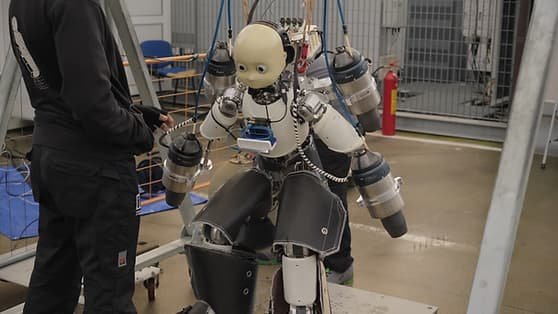
iRonCub3 – A humanoid robot flying with the help of AI and micro jet turbines.
Flying Humanoid Robot iRonCub3 is a ground breaking humanoid robot developed by the Italian Institute of Technology (IIT) that has set a major milestone in the world of robotics by flying with its jet turbines and real-time AI control. This achievement increases the possibility of human-like robots working in future in areas such as disaster relief exploration and dangerous environments where conventional machines cannot work.
How Does It Fly?
The flight capability of iRonCub3 is based on four micro-jet turbines and neural networks. I shot the ball with a sophisticated AI system that controls the robot’s stability and motion during flight. This AI system is complex and based on neural networks that manage aerodynamic stability in real time. This is important because for a robot with a human-like structure, remaining stable in the air is a big challenge, especially when its arms and legs move. The AI system constantly handles posture changes caused by rapid changes in air flow and movement of the limbs. It integrates multibody dynamics with thrust and balance strategies that allow the robot to hover stably in the air and even move around in the air.
Let’s know about Flying Humanoid Robot iRonCub3
Aerodynamic Stability While flying in the air, the robot faces constant instability due to gusts of wind, its own motion and the air coming out of the turbines. The AI process analyzes all these factors in real-time and maintains stability by adjusting the thrust of the turbines and the position of the robot’s body parts Real-time Processing AI has to process data in milliseconds and respond immediately. This is important to prevent the robot from falling in the air.
Neural Networks of Flying Humanoid Robot iRonCub3
The neural networks used in AI are inspired from the structure of the human brain. These networks are able to learn and recognize patterns so that the robot can adapt to different flight conditions. They control how fast the air flow is changing and what changes are taking place in the posture due to the movement of the limbs. Integrated Control AI is not just responsible for flight but it is integrated with the entire body of the robot. This means that it controls the turbines as well as the movement of the robot’s arms and legs to make the flight more efficient and stable.
Importance and Future Applications of iRonCub3
The success of iRonCub3 is more than just a technical achievement. It has many important implications and future applications Disaster Response: Flying humanoid robots like iRonCub3 can play a vital role in rescue operations in disaster-stricken areas. They can reach places where humans or conventional machines cannot reach such as collapsed buildings, flooded areas or places with dangerous chemical leaks. They can locate victims, deliver supplies and collect vital information.
Work in Hazardous Environments
Robots like iRonCub3 can reduce the risk to human workers in hazardous environments such as maintenance at nuclear power plants, hazardous waste disposal or industrial sites with the presence of toxic gases. They can inspect and repair sensitive equipment or handle hazardous materials.
Defense and Security
Flying humanoid robots in military and security applications can be used for reconnaissance, surveillance and even some special missions. Improving Human-Robot Interaction: The human-like structure and mobility of iRonCub3 can improve human-robot interaction. It can make the robots more natural. This can help in future to provide assistance in hospitals, homes and other public places
Advancing Robotics Research Flying Humanoid Robot iRonCub3
The development of iRonCub3 will open up new research opportunities in the field of robotics, AI and control engineering. It will pave the way for the development of even more advanced and capable robots in future
Challenges and Future Directions Although iRonCub3 has achieved an important milestone, there are still some challenges and opportunities for future development Battery Life and Energy Efficiency Jet turbines consume a lot of energy which limits the flight time of the robot.
The focus of future research will be on the development of more efficient propulsion systems and longer-lasting batteries Payload Capacity Currently the primary focus of iRonCub3 is on flight capability In future it will be important to increase the payload capacity of the robot so that it can carry various tools or other materials Dost and Manufacturing Manufacturing such advanced robots is expensive. Large-scale deployment will require reducing costs and streamlining manufacturing processes. Ethical and Social Considerations Before the widespread use of flying humanoid robots.




Imagine rescue missions, spacewalks, or disaster zones handled by flying humanoid robots. This tech is a game-changer!